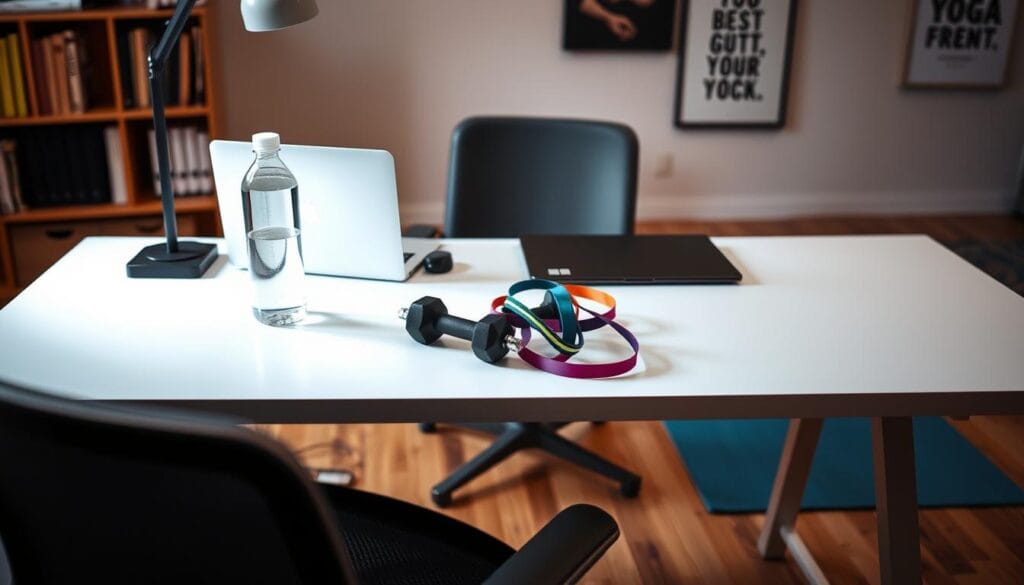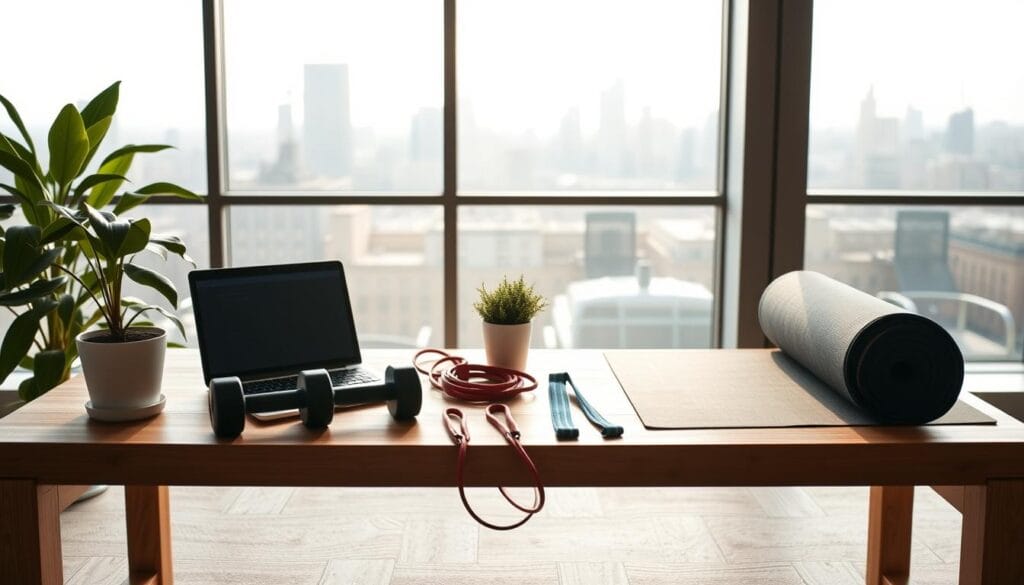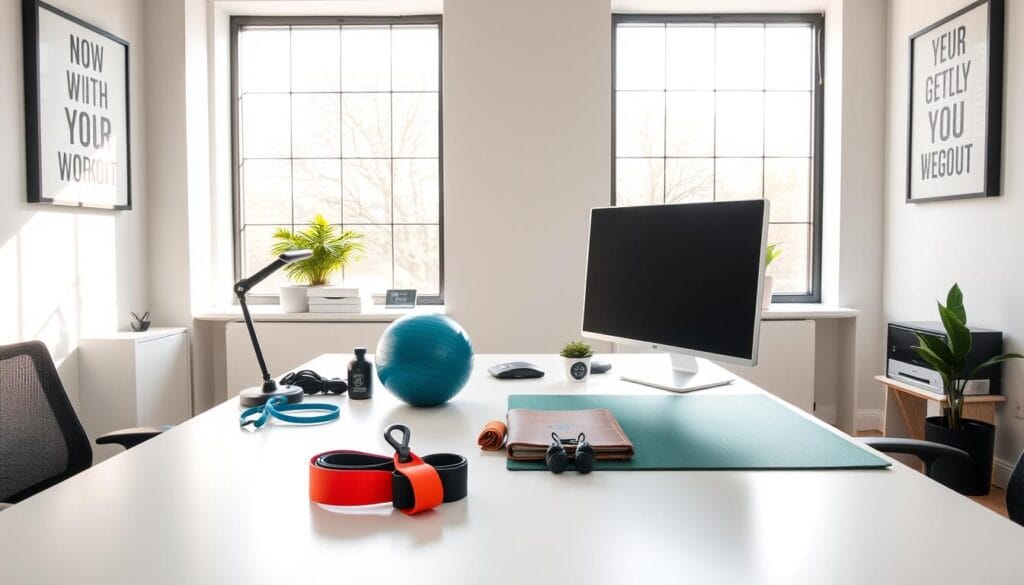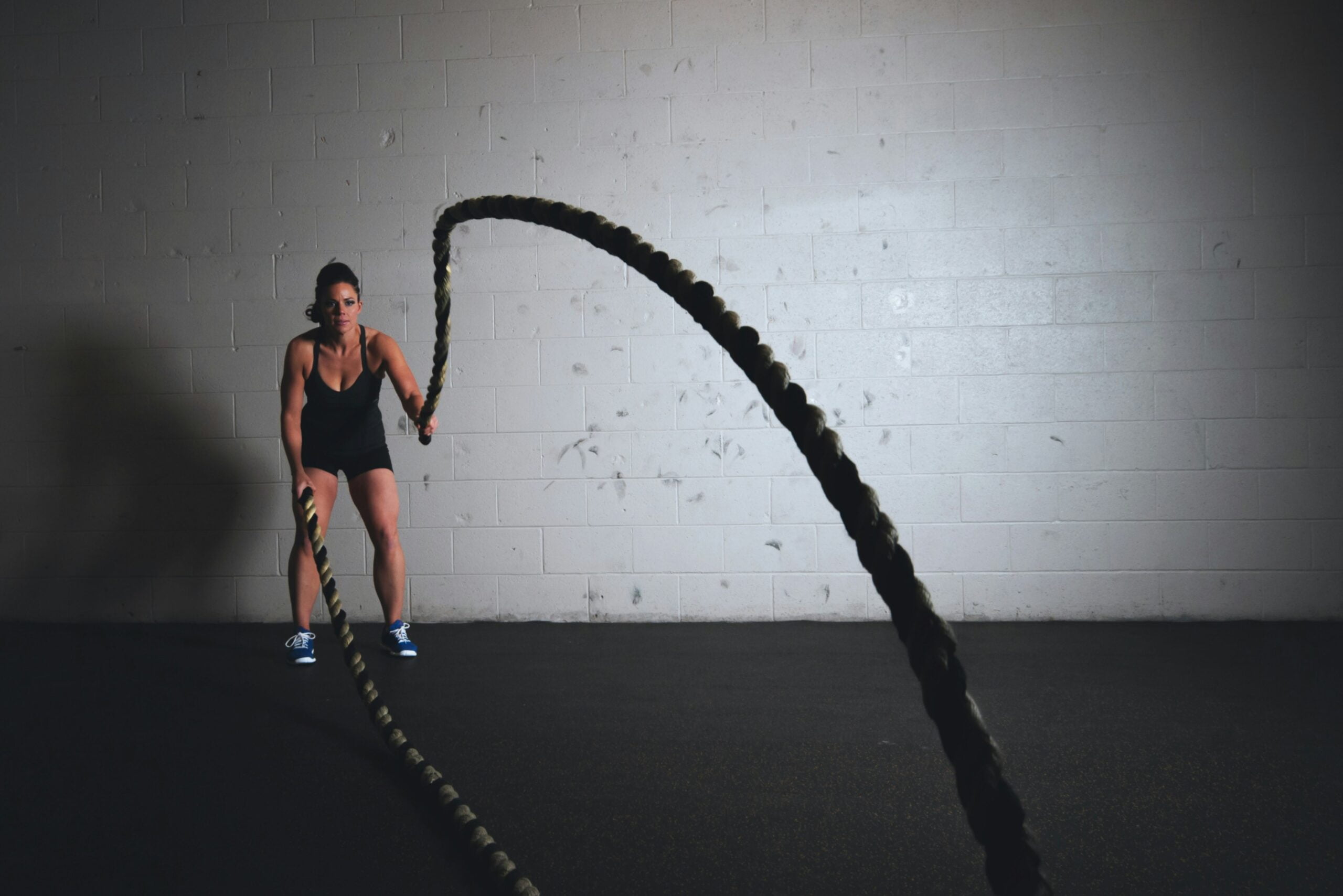Pre and Post Workout for Results Pre Workout Fuel: Energize for Success Pre and post-exercise…
As an Amazon Associate I earn from qualifying purchases.

Great Desk Workout Tips to Boost Productivity
Feeling stiff, tired, or sluggish while working? You’re not alone. Incorporating physical activity into your workday can make a significant difference.
Being active at work not only boosts energy but also eases tension. Simple movements can be done without leaving your workspace, making it easier to stay active throughout the day.
By incorporating these simple tips, you can improve your overall well-being and productivity. It’s about making small changes to your daily routine to achieve a healthier work-life balance.
Key Takeaways
- Simple movements can boost energy and ease tension.
- Incorporating physical activity into your workday improves overall well-being.
- Small changes to your daily routine can lead to a healthier work-life balance.
- Staying active at work is easier than you think.
- Productivity can be improved through simple desk workouts.
The Hidden Dangers of Sitting All Day
As we navigate our increasingly sedentary work lives, it’s crucial to understand the hidden dangers associated with sitting all day. In today’s fast-paced work environment, many employees spend a significant portion of their day seated at their desks, often without realizing the potential health risks.
Prolonged sitting has been linked to various health issues, ranging from cardiovascular disease to metabolic disorders. Understanding these risks is the first step towards mitigating them.
Physical Health Risks of Prolonged Sitting
Sitting for extended periods can lead to a range of physical health problems. Cardiovascular disease is one of the most significant risks, as prolonged sitting can lead to poor blood circulation and increased blood pressure. Additionally, a sedentary lifestyle is associated with a higher risk of developing type 2 diabetes and certain types of cancer.
| Health Risk | Description | Prevention Strategy |
|---|---|---|
| Cardiovascular Disease | Poor blood circulation and increased blood pressure | Regular desk exercises, such as seated leg lifts |
| Type 2 Diabetes | Insulin resistance due to inactivity | Incorporate office workout ideas like desk squats |
| Certain Cancers | Increased risk due to prolonged inactivity | Take regular breaks for stretching exercises |
How Sedentary Work Affects Mental Performance
A sedentary work lifestyle not only affects physical health but also has a significant impact on mental performance. Prolonged sitting can lead to decreased productivity, increased fatigue, and a higher risk of mental health disorders such as depression and anxiety. Incorporating exercises at your desk can help mitigate these effects by improving blood flow to the brain and boosting energy levels.
By understanding the risks associated with prolonged sitting, individuals can take proactive steps to reduce these dangers, such as incorporating office workout ideas into their daily routine.
Why Desk Workouts Are Essential for Modern Workers
By integrating simple exercises into your workday, you can significantly boost your energy levels and focus. In today’s fast-paced work environment, staying active is crucial for maintaining productivity and overall health. Desk workouts offer a practical solution to the sedentary nature of many jobs, allowing you to stay active at work without needing to leave your desk.

Desk workouts provide numerous benefits that can enhance your workday. Let’s explore some of the immediate advantages you can experience by incorporating desk exercises into your routine.
Immediate Benefits: Energy, Focus, and Mood
Engaging in desk workouts can have immediate effects on your energy levels, focus, and overall mood. These exercises help increase blood flow and oxygenation to the brain, which can lead to improved concentration and mental clarity. Some of the immediate benefits include:
- Increased energy levels
- Enhanced focus and concentration
- Improved mood and reduced stress
Physical Benefits: Reducing Pain and Preventing Injury
Regular desk workouts can also have significant physical benefits, particularly in reducing pain and preventing injuries associated with prolonged sitting. By strengthening muscles and improving flexibility, you can alleviate common issues such as back pain and carpal tunnel syndrome. Key physical benefits include:
- Reduced muscle tension and pain
- Improved posture and reduced risk of injury
- Enhanced overall physical well-being
Long-term Health Advantages of Regular Movement
In addition to the immediate and physical benefits, incorporating desk workouts into your daily routine can have long-term health advantages. Regular movement can help mitigate the risks associated with a sedentary lifestyle, such as cardiovascular disease, diabetes, and obesity. Some long-term benefits include:
- Reduced risk of chronic diseases
- Improved cardiovascular health
- Enhanced overall longevity and quality of life
By making desk workouts a part of your daily routine, you can experience these benefits firsthand and improve your overall well-being.
10 Effective Desk Workout Exercises You Can Do Right Now
Discover the power of desk workouts with our top 10 exercises that can be done right at your workstation, helping you stay fit and focused. These exercises are designed to combat the negative effects of prolonged sitting and enhance your overall well-being.

1. Seated Leg Lifts: Strengthen Your Lower Body
Seated leg lifts are an excellent way to engage your lower body without leaving your chair. To perform this exercise correctly, sit up straight and lift one leg off the floor, keeping it straight.
How to Perform Correctly
Lift your leg to a comfortable height, hold for a few seconds, and then lower it back down without touching the floor. Repeat with the other leg.
Variations for Different Fitness Levels
For beginners, start with small lifts and gradually increase the height as you build strength. Advanced users can add ankle weights for extra resistance.
| Repetition | Beginner | Advanced |
|---|---|---|
| Sets | 3 sets | 5 sets |
| Reps per set | 10 reps | 20 reps |
2. Shoulder Rolls: Release Upper Body Tension
Shoulder rolls are a simple yet effective way to release tension in your upper body. Roll your shoulders forward and backward in a circular motion.
Proper Technique for Maximum Benefit
Keep your arms relaxed and let your shoulders do the work. Repeat for several repetitions to loosen up tight muscles.
Combining with Deep Breathing
Enhance the exercise by inhaling as you roll your shoulders back and exhaling as you roll them forward, promoting relaxation.
3. Neck Stretches: Combat Tech Neck and Headaches
Neck stretches can help alleviate the strain caused by prolonged computer use. Gently tilt your head to the side, bringing your ear towards your shoulder.
Safe Stretching Techniques
Hold the stretch for a few seconds and then release. Avoid bouncing or forcing the stretch.
When and How Often to Perform
Perform neck stretches every hour to prevent stiffness and reduce the risk of developing tech neck.
4. Seated Core Twist: Engage Your Abdominals
The seated core twist targets your abdominal muscles. Sit up straight and twist your torso to one side, keeping your feet on the floor.
Step-by-Step Instructions
Twist to one side, hold for a moment, and then twist to the other side. Repeat for several repetitions.
Modifications for Office Chairs
If your chair has arms, you can use them for support. For chairs without arms, keep your hands on your lap or on your thighs.
5. Wrist and Hand Stretches: Relief for Typists
Wrist and hand stretches are crucial for individuals who spend a lot of time typing. Gently extend your wrist, holding your hand in a straight line with your forearm.
Preventing Carpal Tunnel Syndrome
Regular stretching can help prevent carpal tunnel syndrome by keeping your wrists flexible.
Quick Stretches Between Tasks
Take short breaks to stretch your wrists and hands, especially during long typing sessions.
6. Wall Push-Ups: Build Upper Body Strength
Wall push-ups are a modified version of traditional push-ups that can be done near your workstation. Stand with your feet shoulder-width apart and place your hands on a wall at shoulder height.
Finding Space in Your Office
Look for a clear wall space where you can perform push-ups without obstruction.
Adjusting Difficulty Levels
For an easier version, stand further away from the wall. To increase difficulty, stand closer to the wall or try single-arm wall push-ups.
7. Standing Calf Raises: Improve Lower Leg Circulation
Standing calf raises can be done while standing near your desk. Raise your heels off the ground, standing on your tiptoes.
Incorporating Into Standing Tasks
Perform calf raises while you’re on a call or waiting for a file to download, making the most of your time.
Benefits for Those Who Sit All Day
This exercise helps counteract the negative effects of prolonged sitting by improving circulation in your lower legs.
8. Desk Squats: Activate Your Largest Muscles
Desk squats engage your glutes and leg muscles. Stand up and squat down, keeping your back straight and using your chair for support if needed.
Proper Form for Office Squats
Lower yourself down slowly and push back up to the starting position, squeezing your glutes at the top.
Using Your Chair as Support
For added stability, place your hands on the chair or desk as you squat.
9. Ankle Circles: Combat Poor Circulation
Ankle circles are a discreet way to improve circulation. Lift your feet off the floor and draw circles with your ankles.
Performing Discreetly at Your Desk
This exercise can be done while seated, making it perfect for busy work environments.
Combining with Other Foot Exercises
Alternate between ankle circles and toe raises to keep your feet and ankles active.
10. Breathing Breaks: Reduce Stress and Increase Oxygen
Breathing breaks involve taking deep, controlled breaths. Sit comfortably and inhale deeply through your nose, holding your breath for a few seconds before exhaling.
Simple Breathing Techniques
Focus on your breath, letting go of distractions. Regular deep breathing can reduce stress and improve focus.
Combining with Mindfulness Practices
Pair your breathing exercises with mindfulness techniques, such as meditation or visualization, for enhanced benefits.
Creating Your Personal Desk Workout Routine
To maximize the benefits of desk workouts, it’s essential to create a personalized routine that fits your work style and schedule. This involves understanding how often you should move during work hours and tailoring your exercise schedule accordingly.
Optimal Movement Frequency During Work Hours
The frequency of movement during work hours can significantly impact your productivity and health. Research suggests that short bursts of activity every 30 to 60 minutes can be highly effective in reducing the risks associated with prolonged sitting. I recommend starting with a manageable frequency, such as moving every 60 minutes, and adjusting as needed based on your comfort and work demands.
For instance, you could take a 5-minute break to stretch or do a quick set of desk exercises. This not only helps in reducing physical inactivity but also boosts your energy levels and concentration. Consistency is key; moving a habit will yield better results over time.
| Movement Frequency | Benefits | Example Activities |
|---|---|---|
| Every 30 minutes | High energy boost, improved circulation | Short walk, stretching |
| Every 60 minutes | Balanced energy, reduced sitting risks | Desk exercises, leg lifts |
| Every 2 hours | Moderate energy boost, flexibility | Short breaks, shoulder rolls |
Sample Schedules for Different Work Styles
Different work styles require tailored approaches to incorporating desk workouts. For those with highly demanding or variable schedules, flexibility is crucial. You might consider shorter, more frequent breaks or adjusting your routine based on your daily task list.
For example, if you have a meeting-heavy day, you could use the time between meetings to fit in some quick exercises. On days with focused work, taking short breaks to stretch or move around can be beneficial.
Here’s a simple schedule you can adapt: Start your day with a few minutes of stretching, take regular breaks to move around, and end your workday with some relaxing stretches to unwind.
Overcoming Common Obstacles to Desk Workouts
Despite the benefits of exercising at your desk, many of us face challenges that prevent us from maintaining a consistent routine. Whether it’s a busy schedule, limited office space, or concerns about what coworkers might think, these obstacles can be significant. However, with the right strategies, it’s possible to overcome them and make desk workouts a sustainable part of your workday.
Solutions for “Too Busy” Days
One of the most common excuses for not doing desk exercises is being too busy. However, even on the busiest days, it’s possible to fit in a few simple exercises. For instance, you can do seated leg lifts or shoulder rolls while you’re on a call or between tasks. The key is to integrate these exercises into your existing workflow so that they become a habitual part of your day.
Dealing with Office Space Limitations
Limited office space can be another obstacle to desk workouts. However, most desk exercises require little to no space. You can perform wrist and hand stretches, neck stretches, or even seated core twists without needing to leave your desk or have extra space around you. If you have access to a wall, you can even do wall push-ups to get your upper body involved.
Managing Concerns About Coworker Perceptions
Some individuals might feel self-conscious about doing exercises at their desks due to concerns about what their coworkers might think. One approach is to be discreet with your exercises or wait until there’s less activity around you. Alternatively, you can involve your coworkers by suggesting a group break to stretch or move together. This not only helps to normalize the behavior but can also foster a more supportive and healthy work environment.
| Obstacle | Solution | Example Exercises |
|---|---|---|
| Too Busy | Integrate exercises into workflow | Seated leg lifts, shoulder rolls |
| Limited Space | Choose space-efficient exercises | Wrist and hand stretches, neck stretches |
| Coworker Perceptions | Be discreet or involve coworkers | Seated core twists, wall push-ups |
Practical Tools and Resources for Your Desk Workout Journey
As you start your office workout ideas, having the right practical tools can make all the difference. Incorporating desk workouts into your daily routine can be made easier and more effective with the help of various tools and resources.
Apps and Timers to Remind You to Move
There are several apps designed to remind you to move throughout the day. Some popular options include Stand Up!, which reminds you to stand up and move, and Stretchclock, which offers customizable stretching exercises. These apps can be invaluable in maintaining a consistent workout routine at your desk.
Using a timer can also be beneficial. Setting a timer to go off every hour can remind you to take a few minutes to stretch or do some simple exercises, helping you stay on track with your office workout ideas.
Simple Equipment to Enhance Your Desk Exercises
While many desk workouts require no equipment at all, having some simple tools can add variety to your routine. Resistance bands are lightweight and can be used for a variety of exercises, such as banded shoulder rotations and banded leg lifts.
A small exercise ball can also be useful, not just for exercises but also as an alternative to your office chair, helping improve your posture.
Creating a Movement-Friendly Workspace
Creating a workspace that encourages movement is crucial. This can be as simple as rearranging your office layout to allow for more standing or moving around. Consider using a standing desk or a monitor riser to alternate between sitting and standing throughout the day.
By incorporating these practical tools and resources, you can make your desk workout routine more enjoyable and effective, helping you stay committed to your office workout ideas.
Conclusion: Small Movements, Big Impact on Your Workday
Incorporating desk workouts into my daily routine has been a game-changer. By understanding the risks associated with prolonged sitting and the benefits of staying active at work, I can take the first step towards a healthier lifestyle.
Simple exercises like seated leg lifts, shoulder rolls, and neck stretches can be done at my desk, improving my overall health and productivity. By making these small movements a habit, I can reduce the negative effects of a sedentary workday and stay active at work.
As I move forward, I will continue to prioritize my health by incorporating these exercises into my daily routine, reminding me that even small movements can have a significant impact on my workday and overall well-being.
FAQ
What are some simple exercises I can do at my desk?
You can try seated leg lifts, shoulder rolls, neck stretches, seated core twists, wrist and hand stretches, and ankle circles, all of which are great exercises to do at your desk to stay active.
How often should I do desk workouts throughout the day?
It’s recommended to move every 30-60 minutes, so try to incorporate desk exercises into your routine a few times a day to stay energized and focused.
Are desk workouts suitable for everyone, regardless of fitness level?
Yes, most desk exercises can be modified to suit different fitness levels, and they are a great way to stay active, even for those who are just starting with exercise or have mobility issues.
Can desk workouts make a difference in my overall health?
Incorporating desk workouts into your daily routine can help reduce the risks associated with prolonged sitting, improve your mood, and boost your energy levels, all contributing to better overall health.
Do I need any special equipment to do desk workouts?
No, most desk exercises require no equipment at all, although some simple tools like a resistance band or a fitness ball can be useful for certain exercises and can enhance your workout.
How can I stay motivated to continue with my desk workout routine?
You can stay motivated by setting reminders to move, tracking your progress, and varying your exercises to keep things interesting, as well as finding a workout buddy or using apps designed to encourage physical activity throughout the day.
Amazon and the Amazon logo are trademarks of Amazon.com, Inc or it's affiliates.
Related Posts
- Pre and Post Workout for Results
- Probiotic Foods Boost Digestive Health
Probiotic Foods Boost Digestive Health Healthy Gut Microbiome Introduction: The Importance of Gut Health Your…
- 12-Week Home Workout Plan
12-Week Home Workout Plan Why Choose a 12-week Home Workout Plan? With our busy schedules…


